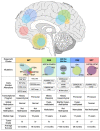Hemispherical Pediatric High-Grade Glioma: Molecular Basis and Therapeutic Opportunities
- PMID: 33348922
- PMCID: PMC7766684
- DOI: 10.3390/ijms21249654
Hemispherical Pediatric High-Grade Glioma: Molecular Basis and Therapeutic Opportunities
Abstract
In this review, we discuss the molecular characteristics, development, evolution, and therapeutic perspectives for pediatric high-grade glioma (pHGG) arising in cerebral hemispheres. Recently, the understanding of biology of pHGG experienced a revolution with discoveries arising from genomic and epigenomic high-throughput profiling techniques. These findings led to identification of prevalent molecular alterations in pHGG and revealed a strong connection between epigenetic dysregulation and pHGG development. Although we are only beginning to unravel the molecular biology underlying pHGG, there is a desperate need to develop therapies that would improve the outcome of pHGG patients, as current therapies do not elicit significant improvement in median survival for this patient population. We explore the molecular and cell biology and clinical state-of-the-art of pediatric high-grade gliomas (pHGGs) arising in cerebral hemispheres. We discuss the role of driving mutations, with a special consideration of the role of epigenetic-disrupting mutations. We will also discuss the possibilities of targeting unique molecular vulnerabilities of hemispherical pHGG to design innovative tailored therapies.
Keywords: ATRX; G34R; HGG; cancer; epigenetics; hemispheric pHGG; pHGG; pediatric high-grade glioma.
Conflict of interest statement
The authors declare no conflict of interest.
Figures



References
-
- Louis D.N., Perry A., Reifenberger G., von Deimling A., Figarella-Branger D., Cavenee W.K., Ohgaki H., Wiestler O.D., Kleihues P., Ellison D.W. The 2016 World Health Organization Classification of Tumors of the Central Nervous System: A summary. Acta Neuropathol. 2016;131:803–820. doi: 10.1007/s00401-016-1545-1. - DOI - PubMed
Publication types
MeSH terms
Substances
Grants and funding
- R37-NS094804/NS/NINDS NIH HHS/United States
- R01-NS105556/NS/NINDS NIH HHS/United States
- 1R21NS107894/NS/NINDS NIH HHS/United States
- R01-NS076991/NS/NINDS NIH HHS/United States
- R01-NS096756/NS/NINDS NIH HHS/United States
- -/Department of Neurosurgery, University of Michigan
- -/Rogel Cancer Center, University of Michigan
- -/Program in Cancer Hematopoiesis and Immunology (CHI)
- -/Leah's Happy Hearts Foundation
- F046166/RNA Biomedicine
- -/Forbes Foundation Award
- -/University of Michigan Medical School
- -/the Rogel Cancer Center Scholar Award to M.G.C
LinkOut - more resources
Full Text Sources
Medical

